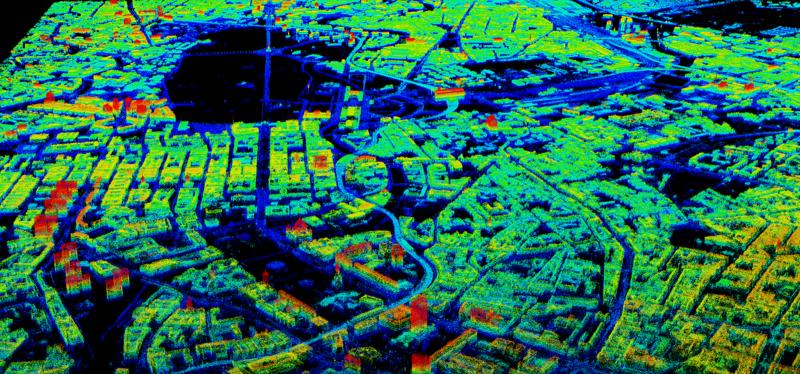World record in information retrieval from satellite data
Watching cities grow

The world's major cities are growing. According to United Nations estimates, today approximately half of the world's population is already living in cities. By 2050 the figure is expected to grow to two thirds of the world´s population. "This growth places high demands on building and infrastructure safety, since damage events can endanger thousands of human lives at once," says Xiaoxiang Zhu, Professor for Signal Processing in Earth Observation at TUM.
Together with her team she has developed a method for early detection of potential dangers: for example, subterranean subsidence can result in the collapse of buildings, bridges, tunnels or dams. The new method makes it possible to detect and visualize changes as small as one millimeter per year.
Three-dimensional radar views of the world's major cities
The data for the new urban images come from the German TerraSAR-X satellite, the most high resolution civilian radar satellite in the world. Orbiting the earth at an altitude of approximately 500 kilometers since 2007, the satellite sends microwave pulses to the earth and then collects their echoes. "Initially these measurements are only in a two dimensional image with a resolution of one meter," Zhu explains.
The TUM professor collaborates with the German Aerospace Center (DLR), where she is also in charge of her own working group. The DLR is responsible for operating and use of the satellite for scientific purposes. "The significance of the images is limited by the fact that reflections from different objects that are at an equal distance from the satellite will layover with each other. This effect reduces the three-dimensional world to a two-dimensional image."
Not only has Zhu developed her own algorithm which makes it possible to reconstruct the third and even fourth (time) dimension, she set a world record at the same time: Four dimensional point clouds with a density of three million points per square kilometer are reconstructed. This rich retrieved information makes it possible to generate highly precise four-dimensional city models.
Different perspectives produce a three dimensional radar image
The trick: The scientists use images taken from slightly different perspectives. The satellite flies over the region of interest every eleven days. However, its orbit position is not always exactly the same. The researchers use these 250-meter orbital variations in radar tomography in order to localize every point in three-dimensional space. This method uses the same principle as used by computer tomography, which creates a three-dimensional view of the inside of the human body: A variety of radar images taken from different perspectives are combined to create a three-dimensional image.
"Since this method processes only a poor resolution in the third dimension, we apply additional compressive sensing methods that make it possible to improve the resolution by 15 times," says Zhu.
Scientists can use the radar measurements from the TerraSAR-X to reconstruct urban infrastructure on the earth's surface with great precision, for example the 3D shape of individual buildings. The method has already been used to generate highly precise 3-D models of Berlin, Las Vegas, Paris and Washington, D.C.
The fourth dimension
Since the images are taken at different times, it's possible to estimate the change over time – the fourth dimension – at the order of a fraction of the radar wavelength. The resulting 4-D model reveals the tiny changes with a precision on the order of approximately one millimeter per year, for example the thermal expansion of buildings in the summer or deformations resulting from subsidence below the earth's surface. Zhu explains, "The method is suitable for the detection of danger points. Satellite technology can thus make an important contribution to making our urban infrastructure safer."
In the future the researchers even intend to watch major cities grow. In the recently launched ERC project "So2Sat", all the world's metropolitan areas are being mapped and observed on a long-term basis. The investigations are centered on newly industrializing countries, where entire urban neighborhoods spring up almost overnight. Zhu and her team plan to use various Big Data sources for the first time: Measurements from satellites will be fused with map information from Open Street Map and the practically unlimited stream of images, text and activity patterns provided by social networks.
---
The Leibniz Supercomputing Center (LRZ) supports the researchers in handling the enormous amount of data.
Multimedia
Publications:
- Kang J., Wang Y., Körner M., Zhu X.: "Robust Object-based Multipass InSAR Deformation Reconstruction", IEEE Transactions on Geoscience and Remote Sensing, in press. DOI: 10.1109/TGRS.2017.2684424
http://ieeexplore.ieee.org/document/7926387/ - Wang, Y., Zhu, X.X., Zeisl, B., Pollefeys, M., 2017: "Fusing Meter-Resolution 4-D InSAR Point Clouds and Optical Images for Semantic Urban Infrastructure Monitoring", IEEE Transactions on Geoscience and Remote Sensing, Volume: 55, Issue: 1, Jan. 2017; DOI: 10.1109/TGRS.2016.2554563
http://ieeexplore.ieee.org/document/7587405/ - Montazeri S., Zhu X., Eineder M., Bamler R., 2016: "3-D Deformation Monitoring of Urban Infrastructure by Tomographic SAR Using Multi-Track TerraSAR-X Data Stacks", IEEE Transactions on Geoscience and Remote Sensing, Volume: 54, Issue: 12, Dec. 2016; DOI: 10.1109/TGRS.2016.2585741
http://ieeexplore.ieee.org/document/7548332/
Contact:
Prof. Xiaoxiang Zhu
Technical University of Munich
Professorship for Signal Processing in Earth Observation
Tel: +49 8153283531
xiaoxiang.zhu@tum.de